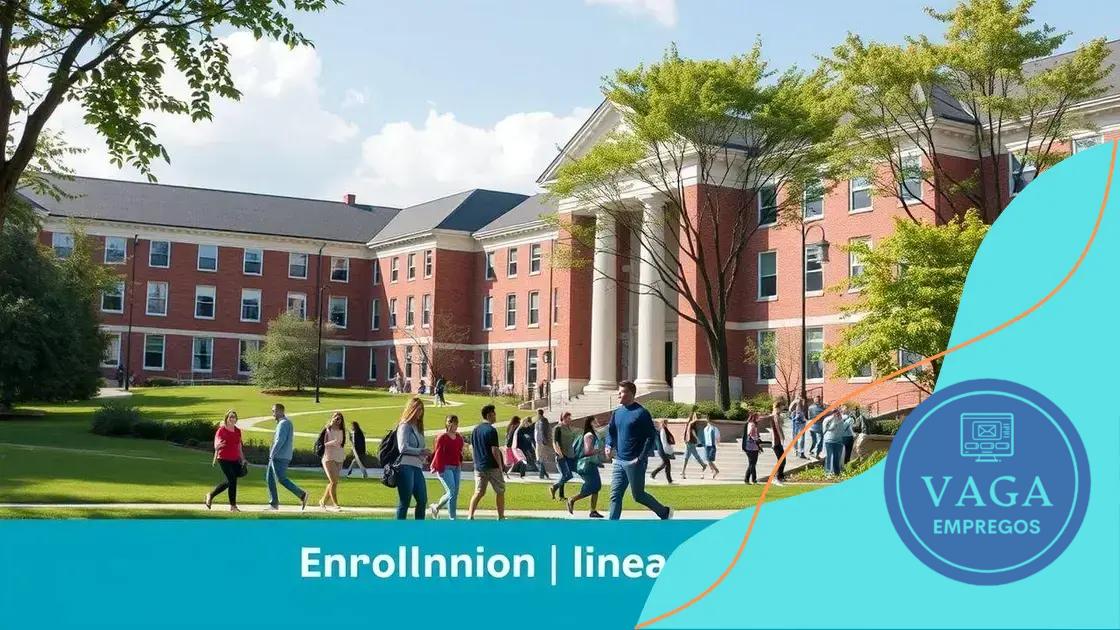Public universities face enrollment shortfalls in 2025

Advertisement
Public universities face enrollment shortfalls in 2025 due to economic pressures, changing societal values on education, and demographic shifts that are influencing student choices across the country.
Public universities face enrollment shortfalls in 2025, sparking concern among students and educators alike. With changing demographics and economic factors at play, what does this mean for the future of higher education?
Advertisement
Understanding the enrollment decline
Understanding the current trends in enrollment is crucial for public universities as they face significant challenges. Over the years, many institutions have witnessed a steady decline in student admissions. This decline raises important questions about the future of education and access to opportunities for many.
Advertisement
Factors affecting enrollment
Several factors influence enrollment rates in universities. They include economic conditions, societal changes, and shifts in student demographics. Understanding these factors can help institutions adapt and attract more students.
- Economic downturns can reduce the number of students able to afford college.
- Changes in societal attitudes towards higher education can influence student choices.
- Demographic shifts, such as declining birth rates, lead to fewer high school graduates.
- Increased competition from other educational pathways, like vocational training, offers alternatives to traditional degrees.
The interplay of these factors can create complex challenges. For instance, many students today are weighing the cost of education against potential debt. Consequently, this has led to a more cautious approach towards college enrollment.
Implications of declining numbers
Public universities face enrollment shortfalls, impacting not only their funding but also their ability to provide essential services to students. With fewer students, universities may need to reconsider their programs and resources. This alteration can lead to program cuts or merges, which ultimately affects the diversity of offerings.
Furthermore, enrollments directly relate to a university’s financial health. With fewer students paying tuition, universities might struggle to maintain their facilities, hire qualified staff, and invest in new technologies. This cycle can lead to further declines as students may choose institutions based on their perceived stability and resources.
Overall, understanding the enrollment decline requires a multifaceted approach. By examining economic, societal, and demographic factors, universities can develop strategies to mitigate these challenges and attract students.
Factors contributing to shortfalls
Many factors contribute to the enrollment shortfalls that public universities experience. Understanding these elements can help in crafting effective strategies to address the issues. The landscape of higher education is continually changing, making it essential to recognize the various influences at play.
Economic Factors
One significant reason for decreased enrollment is economic strain. Students are often grappling with high tuition costs and potential debt. As the job market fluctuates, potential students may hesitate to invest in a degree, fearing financial instability.
- The rising costs of living can deter students from pursuing higher education.
- A lack of job opportunities can lead students to seek immediate work instead of enrolling in college.
- Financial aid uncertainties can make students question affordability.
Moreover, public funding for universities is often tied to enrollment numbers. As fewer students enroll, institutions may find their budgets tightening, leading to cuts that further discourage future students.
Societal Changes
Public universities face enrollment shortfalls partly because of changing societal perceptions of college education. Many young people are reconsidering whether a degree is necessary for their career goals. Alternative paths, such as technical training or apprenticeships, are increasingly seen as valuable.
In addition, there is a growing emphasis on skills acquisition rather than degrees. This shift can prompt students to pursue non-traditional routes, resulting in fewer enrollments at universities. As society adapts to these changes, universities must also evolve to attract students.
Demographic Trends
Demographic shifts also play a crucial role in enrollment patterns. In some regions, declining birth rates mean fewer high school graduates, directly impacting enrollment at universities. Organizations that track enrollment figures note these trends and their implications for future planning.
- Population growth varies by region, affecting university applications.
- Minority group representations in higher education continue to shift, influencing overall enrollment.
- International student trends can fluctuate, impacting total numbers significantly.
In summary, while various economic, societal, and demographic factors contribute to enrollment shortfalls, understanding these dynamics allows universities to adapt and find new ways to connect with potential students.
Impact on university funding
The impact on university funding due to declining enrollment is significant and multifaceted. Public universities often rely heavily on tuition revenue to support their budgets, and fewer enrolled students directly translates to reduced income. This financial strain can affect everything from staffing to program offerings.
Reduced Tuition Revenue
As enrollment numbers drop, universities may face serious financial challenges. Tuition accounts for a large portion of university funding. With fewer students, many institutions might struggle to meet operational costs.
- Cutbacks on programs and services are common as universities seek to manage budgets.
- Some institutions may resort to layoffs or hiring freezes, impacting the quality of education.
- Increased tuition fees may occur to offset losses, further discouraging new students.
This cycle can create long-term consequences as universities grapple with decreased attractiveness, leading to even lower enrollment in subsequent years.
Impact on Financial Aid
Public universities face enrollment shortfalls that can also affect financial aid options. When fewer students enroll, the amount of federal and state support tied to enrollment may also decrease. This can put pressure on financial aid offices.
Consequently, universities might have to alter their financial aid strategies. They could prioritize certain programs or majors to attract more applicants, reducing overall access for students in less popular fields. As funding gets tighter, more students may face challenges securing the financial assistance they need to continue their education.
Long-Term Effects on Institutional Missions
When universities experience funding cuts, they may need to reassess their missions and goals. Some may shift focus towards more lucrative programs while sidelining others. This change can limit students’ choices, reducing the diversity of academic paths available.
Additionally, the long-term reputation of the institution might be impacted. If potential students see declining support for programs, they may question the institution’s value, further perpetuating the enrollment decline.
Student response to changing dynamics
Students are responding to the changing dynamics in higher education with an increasing awareness of their options. As public universities face enrollment shortfalls, many students are exploring alternatives to traditional degrees. This shift reflects broader trends in society and the economy.
Awareness of Alternatives
More students are recognizing that there are various paths to career success. Technical training, online courses, and vocational programs are becoming attractive alternatives. These options often provide quicker or less expensive routes to employment.
- Online learning platforms offer flexibility, allowing students to balance work and study.
- Vocational schools provide hands-on experience in specific trades, which can lead to immediate job opportunities.
- Short-term certifications can enhance skill sets without the long-term commitment of a degree.
While traditional four-year degrees have long been the standard, many students are now considering what is best for their personal and financial situations. They weigh the cost of a degree against potential earnings in their chosen field.
Shifts in Educational Priorities
Additionally, there is a growing emphasis on skills rather than solely on degrees. Companies are increasingly looking for candidates with practical experience and specific abilities. Students are responding to this shift by focusing their education on relevant skills that align with job market demands.
This change requires universities to adapt their programs. Institutions might need to collaborate with industries to ensure that their courses align with real-world requirements. As students voice their priorities, universities have the opportunity to reshape their offerings.
Engagement in Campus Decisions
Students are also becoming more engaged in the decision-making processes at their universities. They want a say in the programs offered and the resources allocated. This enhanced involvement can help universities understand students’ needs better and develop programs that appeal to a broader audience.
As a result, student-led initiatives can influence the future direction of universities. By advocating for relevant programs and resources, they can help their institutions adapt to changing educational landscapes.
Future solutions for enrollment growth
Future solutions for addressing the challenges of declining enrollment at public universities require innovative strategies. Institutions must adapt to the changing educational landscape by finding new ways to attract students. As public universities face enrollment shortfalls, these solutions need to be comprehensive and student-focused.
Enhanced Recruitment Strategies
One potential solution is to enhance recruitment efforts. Universities should rethink their marketing and outreach to communicate the unique benefits they offer. By showcasing campus culture, academic success, and potential career paths, institutions can engage prospective students more effectively.
- Utilizing social media platforms to connect with younger audiences.
- Hosting interactive webinars and virtual campus tours to showcase programs.
- Involving current students in outreach to provide authentic perspectives.
Targeted recruitment efforts for specific demographics can also help improve enrollment figures. By understanding the populations they aim to attract, universities can tailor their messages and outreach strategies accordingly.
Flexible Course Offerings
Flexibility in course offerings is another critical factor in boosting enrollment. As students seek education that fits their lifestyles, universities must adapt. Offering online classes or hybrid models allows students to balance work, family, and education more effectively.
This adaptability can make education more accessible. Institutions could also consider non-traditional scheduling options, such as weekend or evening classes, to accommodate a broader range of students. The goal should be to provide pathways that align with students’ needs.
Collaboration with Local Industries
Partnerships with local industries can also boost enrollment by aligning academic programs with job market demands. By working closely with businesses, universities can develop relevant curricula that prepare students for specific career opportunities. This alignment can increase student interest in particular fields.
Moreover, developing internship and apprenticeship programs can provide students with real-world experiences that enhance their resumes. Such partnerships benefit both students and local economies, fostering a workforce that meets industry needs.
Financial Incentives
Offering financial incentives can significantly impact a student’s decision to enroll. Scholarships, grants, and other financial aid programs can alleviate the burden of tuition costs that deter many potential students. Universities should explore innovative funding options to attract diverse talent.
Additionally, improving financial literacy programs can help students understand the types of aid available and the long-term value of investing in their education. These initiatives can empower students to make informed decisions about their educational futures.
FAQ – Frequently Asked Questions about Enrollment Challenges in Public Universities
What are the main factors contributing to enrollment shortfalls at public universities?
The main factors include economic conditions, societal changes, and demographic trends that influence students’ decisions to enroll.
How can universities enhance their recruitment efforts?
Universities can enhance recruitment by using social media, hosting virtual tours, and engaging current students to share their experiences.
Why is flexibility in course offerings important for attracting students?
Flexibility allows students to balance their education with work and personal commitments, making it easier to enroll and succeed.
What role do industry partnerships play in enrollment growth?
Industry partnerships help universities align their programs with job market demands, increasing relevance and job placement opportunities for students.





